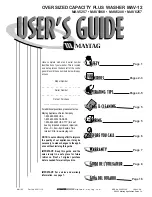
2
EN
LEGEND OF SYMBOLS
Warning/
Grounding/
Electrical Hazard/
Waste/
Safeguarding the environment/
Recycling/
Use gloves
IMPORTANT SAFETY
INSTRUCTIONS
Read the instructions carefully before
using, as they include important information
on safe installation, use and maintenance.
Keep this instruction manual in a safe place
for future reference. If the appliance is sold,
given away or moved, make sure the
manual is kept with the machine.
Remove the appliance from all packaging
and make sure it was not damaged during
transportation, if it was damaged contact
the retailer and do not proceed any further
with the installation process.
When using your dishwasher, follow
the precautions listed below:
• The appliance must be used to wash
domestic crockery in accordance with
the instructions in this manual.
• This appliance can be used by children
aged from 8 years and above and persons
with reduced physical, sensory or mental
capabilities or lack of experience and
knowledge if they have been given
supervision or instruction concerning
use of the appliance in a safe way
and understand the hazards involved.
Children shall not play with the appliance.
• Cleaning and user maintenance shall not
be made by children without supervision.
• The appliance must not be installed
outdoors, even in covered areas. It
is extremely dangerous to leave the
machine exposed to rain and storms.
• Do not store flammable materials in close
proximity to the appliance.
• The water in the appliance is not potable.
• Do not use solvents inside the appliance:
risk of explosion!
• The door should not be left in the open
position since this could present a
tripping hazard.
• Do not rest objects on the open door or sit
or stand on it since the appliance could
trip forward.
• The open appliance door can only
support the weight of the loaded rack
when pulled out.
• The water supply tap must be shut off
and the plug should be removed from
the electrical socket at the end of every
cycle and before cleaning the appliance
for carrying out any maintenance work
also disconnect in the event of any
malfunction.
• Repairs and technical modifications must
be carried out exclusively by a qualified
technician.
• When unplugging the appliance always
pull the plug from the mains socket. Do
not pull on the cable.
• In order to avoid laceration hazard,
usage of special gloves is needed
during the assembling of the appliance.
• During use, the access to the rear wall
should be limited in a sustainable manner
such as approaching the device to the
wall or furniture board.
• Keep packaging materials out of the
reach of Children, packaging materials
should not be used as a toy.
• Children must not be allowed to play with
the appliance.
• Store the detergent, rinse aid and salt out
of the reach of children.
• Appliance is dedicated only for household
use.
• Appliance can not be operated until
installation process is complete.
GROUNDING INSTRUCTIONS
• This appliance must be grounded. In the
event of a malfunction or breakdown,
grounding will reduce the risk of an
electric shock by providing a path of
least resistance of electric current. This
appliance is equipped with a cord having
an equipment- grounding conductor and
a grounding plug.
• The plug must be plugged into an
appropriate outlet that is installed and
grounded in accordance with all local
codes and ordinances.
• Extension cord, adapters and conversion
plugs must not be used to connect the
appliance to the outlet.


































